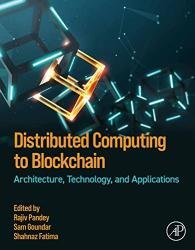Distributed Computing to Blockchain: Architecture, Technology, and Applications
- Добавил: literator
- Дата: 29-04-2023, 16:33
- Комментариев: 0
 Название: Distributed Computing to Blockchain: Architecture, Technology, and Applications
Название: Distributed Computing to Blockchain: Architecture, Technology, and ApplicationsАвтор: Rajiv Pandey, Sam Goundar, Shahnaz Fatima
Издательство: Academic Press/Elsevier
Год: 2023
Страниц: 478
Язык: английский
Формат: pdf (true)
Размер: 37.0 MB
Distributed Computing to Blockchain: Architecture, Technology, and Applications provides researchers, computer scientists, and data scientists with a comprehensive and applied reference covering the evolution of distributed systems computing into blockchain and associated systems. Divided into three major sections, the book explores the basic topics in the blockchain space extending from distributed systems architecture, distributed ledger, decentralized web to introductory aspects of cryptoeconomics (cryptography and economics) of decentralized applications.
The book further explores advanced concepts such as smart contracts; distributed token mining, initial coin offerings; proof of work; public, private, and other blockchains; cryptography; security; and blockchains. The book goes on to review byzantine fault tolerance, distributed ledgers versus blockchains, and blockchain protocols. The final section covers multiple use cases and applications of distributed computing and the future directions for blockchains.
Traditional application development revolved around the client-server architecture. Centralized applications relied on compute-intensive servers with server side (Java, PHP, and Python) and client-side scripting (jаvascript, Angular, and React) as the predominant technology. Decentralized applications or DApps are open-sourced applications, running on peer-to-peer networks, with no central controlling entity. These applications are built on top of blockchain networks and utilize smart contracts to secure user data. While the data are kept secure through encryption, the record of data and transactions is kept completely public and transparent by storing it on the blockchain.
The main difference in the two architectures is that while the centralized applications run the backend on large, centralized web servers, the back-end code for DApps runs on decentralized peer-to-peer networks such as Ethereum (technically can be any other blockchain). Ethereum is being discussed here because they were the pioneer and its large-scale adoption. Also note that it is normally the transactional data which need to be captured irrefutably would normally go into the blockchain to keep the prohibitive costs in check.
Interactions between the DApp front end and the blockchain backend are routed using the APIs, such as the JSON-RPC (JSON remote procedure call, which is a lightweight RPC protocol). What is intriguing is that to the end user, a DApp may just appear identical in feel and functionality to a regular centralized application. It’s what is under the hood that makes DApps different. Technically, DApps can use any blockchain in the backend to store the transactions. But for a regular developer, it would be huge task to set up a blockchain from the scratch, then enable writing of smart contracts, and then build the application on top of that.
Presented as a focused reference handbook describing the evolution of distributed systems, blockchain, and consensus algorithms emphasizing the architectural and functional aspects
Integrates the various concepts of cryptography in blockchain and further extends to blockchain forensics
Provides insight and detailed Interpretation of algorithms for consensus in blockchains
Скачать Distributed Computing to Blockchain: Architecture, Technology, and Applications
Внимание
Уважаемый посетитель, Вы зашли на сайт как незарегистрированный пользователь.
Мы рекомендуем Вам зарегистрироваться либо войти на сайт под своим именем.
Уважаемый посетитель, Вы зашли на сайт как незарегистрированный пользователь.
Мы рекомендуем Вам зарегистрироваться либо войти на сайт под своим именем.
Информация
Посетители, находящиеся в группе Гости, не могут оставлять комментарии к данной публикации.
Посетители, находящиеся в группе Гости, не могут оставлять комментарии к данной публикации.
